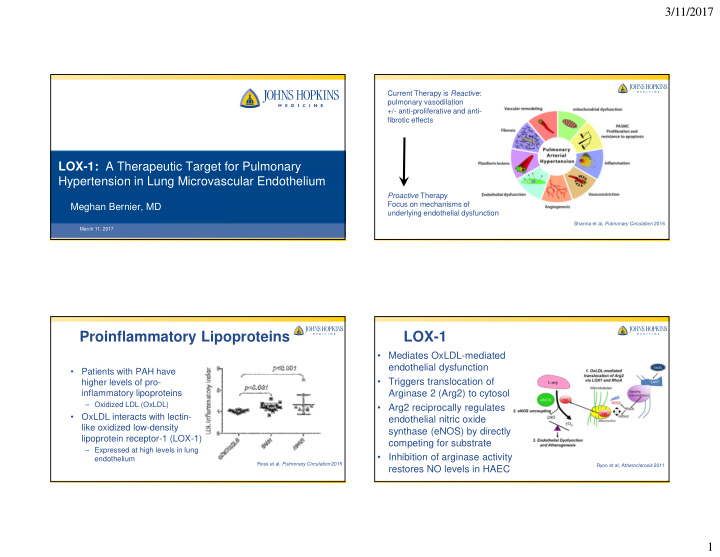



3/11/2017 Current Therapy is Reactive : pulmonary vasodilation +/- anti-proliferative and anti- fibrotic effects LOX-1: A Therapeutic Target for Pulmonary Hypertension in Lung Microvascular Endothelium Proactive Therapy Focus on mechanisms of Meghan Bernier, MD underlying endothelial dysfunction Sharma et al, Pulmonary Circulation 2016 March 11, 2017 Proinflammatory Lipoproteins LOX-1 • Mediates OxLDL-mediated endothelial dysfunction • Patients with PAH have • Triggers translocation of higher levels of pro- inflammatory lipoproteins Arginase 2 (Arg2) to cytosol – Oxidized LDL (OxLDL) • Arg2 reciprocally regulates • OxLDL interacts with lectin- endothelial nitric oxide like oxidized low-density synthase (eNOS) by directly lipoprotein receptor-1 (LOX-1) competing for substrate – Expressed at high levels in lung • Inhibition of arginase activity endothelium Ross et al, Pulmonary Circulation 2015 Ryoo et al, Atheroclerosis 2011 restores NO levels in HAEC 1
3/11/2017 Aims Hypoxia Induces Arg2 in HPMEC • Hypoxia causes oxidative • Define downstream signaling mechanisms by stress in HPMEC • LOX-1 protein levels remain which the LOX-1 receptor mediates pulmonary stable while Arg2 increases microvascular endothelial dysfunction and EndMT and eNOS decreases • Concomitant conditions to examine: • Elucidate the role of LOX-1 signaling in the – OxLDL exposure development of PH in a transgenic mouse model – LOX-1 overexpression – LOX-1 knockout with siRNA Inhibition of Formin mDia1 Animal Models of Vasculopathy Causes Discontinuity of HPMEC VE-Cadherin A B C control 30m 120m • LOX-1 Murine Models: – Overexpression and hypoxia: increased production of ROS, RV hypertrophy, and RVSP – Deletion/Inhibition: decreased inflammation, reduced atherosclerotic burden – Deficiency: Decreased arginase activity Blue: DAPI ; Green: VE-Cadherin ; Red: F-actin 2
3/11/2017 LOX-1 KO May Attenuate SuHx Next Steps Effects • Hypoxia and HPMEC • LOX-1 KO Mice and SuHx Model – LOX-1 gain and loss of • Sugen-Hypoxia function – Replicate findings Model – Arginase expression and – Hematologic samples • Young adult mice activity – Histology (10 weeks) – NO production/ ROS – Arg2/eNOS expression • 3 weekly Sugen generation via FACS – EndMT, hypoxia, LOX-1 injections – Arginase activity, NO and the actin cytoskeleton production in EC from • Concomitant FiO 2 10% these mice Funding Acknowledgements • T32 training grant in Pediatrics • Mentors: Drs Lewis Romer and Larissa Shimoda • Colleagues: (NRSA 5T32HD044355-12) – Shimoda Lab: Karthik Suresh, Jon Huetsch, Haiyang Jaing – Romer and Berkowitz Labs: Anil Bhatta, Deepesh Pandey, • The 2016 Christen White Cranford Thorsten Leucker, Andrea Wecker, Ariel Jacob, Max Rossberg Pediatric PH Research and Mentoring – Johns Lab: Johns Skinner, Roger Johns Grant 3
3/11/2017 References References • Ciuclan L, Bonneau O, Hussey M, et al. A novel murine model of severe pulmonary arterial hypertension. • Ryoo S, Bhunia A, Chang F, Shoukas A, Berkowitz DE, Romer LH. OxLDL-dependent activation of Am J Respir Crit Care Med 2011;184:1171-82. arginase II is dependent on the LOX-1 receptor and downstream Rho A signaling. Atherosclerosis 2011;214:279-87 • Gomez-Arroyo J, Saleem SJ, Mizuno S, et al. A brief overview of mouse models of pulmonary arterial hypertension: problems and prospects. Am J Physiol Lung Cell Mol Physiol 2012;302:L977-91. • Sharma S, Ruffenach G, Umar S, Motayagheni N, Reddy ST, Eghbali M. Role of oxidized lipids in pulmonary arterial hypertension. Pulm Circ 2016;6:261-73. • Jiang JX, Zhang SJ, Liu YN, et al. EETs alleviate ox-LDL-induced inflammation by inhibiting LOX-1 receptor expression in rat pulmonary arterial endothelial cells. Eur J Pharmacol 2014;727:43-51. • Stenmark KR, Meyrick B, Galie N, Mooi WJ, McMurtry IF. Animal models of pulmonary arterial hypertension: the hope for etiological discovery and pharmacological cure. Am J Physiol Lung Cell Mol • Nikitopoulou I, Orfanos SE, Kotanidou A, et al. Vascular endothelial-cadherin downregulation as a feature Physiol 2009;297:L1013-32. of endothelial transdifferentiation in monocrotaline-induced pulmonary hypertension. Am J Physiol Lung Cell Mol Physiol 2016;311:L352-63 • Touyz RM. Linking LOX-1 and arginase II through mitochondria: a novel paradigm in endothelial dysfunction. Circ Res 2014;115:412-4. • Pandey D, Bhunia A, Oh YJ, et al. OxLDL triggers retrograde translocation of arginase2 in aortic endothelial cells via ROCK and mitochondrial processing peptidase. Circ Res 2014;115:450-9. • Vitali SH, Hansmann G, Rose C, et al. The Sugen 5416/hypoxia mouse model of pulmonary hypertension revisited: long-term follow-up. Pulm Circ 2014;4:619-29. • Ross DJ, Hough G, Hama S, et al. Proinflammatory high-density lipoprotein results from oxidized lipid mediators in the pathogenesis of both idiopathic and associated types of pulmonary arterial hypertension. • Xu X, Gao X, Potter BJ, Cao JM, Zhang C. Anti-LOX-1 rescues endothelial function in coronary arterioles Pulm Circ 2015;5:640-8. in atherosclerotic ApoE knockout mice. Arterioscler Thromb Vasc Biol 2007;27:871-7. • Ryoo S, Lemmon CA, Soucy KG, et al. Oxidized low-density lipoprotein-dependent endothelial arginase II • Zhang P, Liu MC, Cheng L, Liang M, Ji HL, Fu J. Blockade of LOX-1 prevents endotoxin-induced acute activation contributes to impaired nitric oxide signaling. Circ Res 2006;99:951 60. lung inflammation and injury in mice. J Innate Immun 2009;1:358-65. 4
Recommend
More recommend